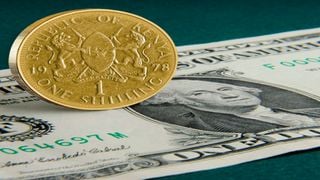
The Kenya shilling could finally be finding a new footing after it slowed down its monthly free fall to one percent.
| FileBusiness
Premium
Shilling free fall slows after CBK reins in banks
The Kenya shilling could finally be finding a new footing after it slowed down its monthly free fall to one percent so far in November from the 4.3 percent in March, weeks after the banking sector regulator asked for an explanation from ten banks on why they were selling dollars exorbitantly.
A tracking of commercial dollar rates offered by four banks, including Equity, NCBA, I&M and Stanbic by the Business Daily also shows that the spread, the difference between buying and selling halved to a mean of 5.8 units this week compared to 10.4 in April as the delta shrinks from the peak of 16 units.
The narrowing of the spreads/margins comes barely a month after CBK Governor Kamau Thugge told MPs that he had written to 10 main banks asking them to explain why spreads had remained wide despite interbank reforms.
“What you are looking at are the effects of getting the interbank forex market working. The market is starting to work, but it takes a really long time to get confidence back,” noted Muathi Kilonzo, the managing director of Frontier Equity Sales & Head of Equities Kenya at EFG Hermes.
Last Thursday, the CBK quoted the local unit at Sh152.22 against the US dollar, while on Friday, Equity Bank was buying dollars at Sh151.6 and selling at Sh156.6, a spread of 4.3 units.
Moreover, CBK dollar indicative rates have shown convergence by closing ranks to commercial dollar rates as offered by banks.
According to market analysts, the developments point to evidence of an improving interbank foreign exchange market as more forex trades happen between banks.
In March, the CBK restarted the interbank forex market with the view of stemming what was then a runway dollar shortage crisis.
Previously, banks sold dollars to each other at commercial rates or refused to sell hard currency outside their traditional networks.
Greater efficiency in interbank forex trades, including higher volumes is expected to guide the local currency to new levels of stability even as market participants struggle to get a grip of the shilling’s fair valuation. “The parallel market is beginning to merge with the interbank market and we see the demand for the shilling increasing. For me, however, there is no such thing as the true value of a currency as this is determined by demand and supply,” noted a bankermon condition of anonymity.
According to sources, the last two weeks have seen more banks giving electronic quotes for forex trades, a move set to improve price discovery for the Kenyan currency.
Last week, the International Monetary Fund (IMF) acknowledged reforms in foreign exchange market but warned against complacency in implementation.
“Further efforts to improve the functioning of the FX market and greater exchange rate flexibility would reduce the costs to the real economy from large spreads and excess FX demand, while encouraging capital inflows and reducing outflows,” noted the head of the IMF mission to Kenya Haimanot Teferra.
The depreciation of the local exchange rate has come amid a rise in interest rates in advanced economies which have given way to stronger world currencies such as the US dollar as investors pull their money out of emerging and frontier markets.
Both the National Treasury and the CBK have, however, hinted at a seemingly devaluation/reset of the unit by local authorities after what it termed as the overvaluation of the Kenyan shilling in recent years with Dr Thugge terming the sharp currency depreciation this year as the price to pay for previous management of the forex market.
Cognizant of the correction of policy missteps, market participants, analysts and observers have struggled to tell the fair value of the local unit in the absence of an analysis by the Treasury and CBK on their overvaluation stance.
The local unit’s trading is, however, expected to be influenced by a number of factors going forward, including the direction of the current account deficit, the stock of official reserves and the country’s ability to navigate the Sh304.4 billion ($2 billion) June 2024 Eurobond maturity unscathed.
For banks, thinner margins or spreads on dollar trades will mean a reversal of the huge gains posted from forex trading over the past two years.
Last year, for instance, Co-operative Bank posted a 66 percent rise in forex earnings to Sh4.71 billion from Sh2.84 billion in 2021 while Stanbic, Absa and Standard Chartered recorded a growth of 37, 60 and 58 percent over the same period at Sh8.57 billion, Sh6.64 billion and Sh5.97 billion respectively.





